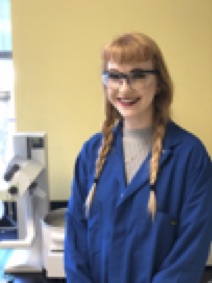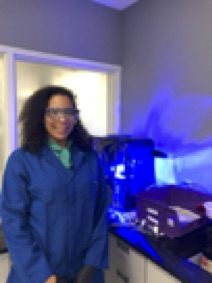Org. Synth. 2019, 96, 455-473
DOI: 10.15227/orgsyn.096.0455
Preparation of 2,4,5,6-Tetra(9H-carbazol-9-yl)isophthalonitrile
Submitted by Saskia M. Engle, Takisha R. Kirkner, and Christopher B. Kelly*
1,2
Checked by Shinsuke Shimizu, Koichi Hagiwara, and Masayuki Inoue
1. Procedure (Note 1)
A.
2,4,5,6-Tetra(9H-carbazol-9-yl)isophthalonitrile (1). A 100 mL, flame-dried, two-necked round-bottomed flask (the central neck: 15/25 joint, side neck: 15/25 joint) is equipped with a 2.4 cm Teflon-coated magnetic oval stir bar. The side-neck is fitted with a 15/25 rubber septum. The central neck is equipped with a water-jacked reflux condenser (25.0 cm height, 15/25 joint). Top of the condenser is fitted with a 15/25 rubber septum, which is equipped with an inlet needle connected to a Schlenk line. The reflux condenser is kept at ambient temperature with a constant flow of water (Figure 1).The assembled apparatus is charged with
9H-carbazole (3.68 g, 22.0 mmol, 4.4 equiv) (Notes
2 and
3) through the side-neck of the flask. The reaction vessel is then evacuated for 5 min and backfilled with argon three times. Then the flask is charged with anhydrous
tetrahydrofuran (36 mL) (Notes
4 and
5) via a 60 mL syringe through the 15/25 rubber septum on the side-neck of the flask. The stirred, homogeneous solution (Figure 2a) is cooled to 0 °C in an ice-water bath for 10 min, then the flask is charged with a solution of
sodium bis(trimethylsilyl)amide in
tetrahydrofuran (2 M, 10.5 mL, 21.0 mmol, 4.2 equiv) (Figure 2b)(
Note 6) using a 12 mL syringe, dropwise over five min (
Note 7).
Figure 1. Set up of glassware for the reaction
Figure 2. (a) 9H-Carbazole in tetrahydrofuran (b) After the addition of sodium bis(trimethylsilyl)amide in tetrahydrofuran
After five min, the ice-water bath is removed, and the solution is stirred at room temperature (26 °C) for 30 min (Figure 3) (
Note 8).
Tetrafluoroisophthalonitrile (1.00 g, 5.00 mmol, 1.0 equiv) (
Note 9) in anhydrous
tetrahydrofuran (4 mL) is then added through the 15/25 rubber septum on the side-neck of the flask via cannula. Additional anhydrous
tetrahydrofuran (2 x 2 mL) is used for the complete transfer. During the addition, the reaction mixture turns from colorless to brown and yellow solid is formed (Figure 4). The reaction vessel is placed in a pre-heated oil bath at 65 °C. The contents of the flask are stirred under an argon atmosphere at this temperature (Figure 5). After 24 h (Notes
10 and
11), the heterogeneous brown solution is cooled to room temperature, then concentrated by rotary evaporation (37 °C, 50 mmHg)(Figure 6) (
Note 12).
Figure 3. The reaction mixture before the addition of tetrafluoroisophthalonitrile
Figure 4. (a) The reaction mixture during the addition of tetrafluoroisophthalonitrile (b) The reaction mixture after the addition of tetrafluoroisophthalonitrile
Figure 5. (a) The reaction mixture before heating for 24 hours. (b) The reaction mixture after heating for 24 hours
Figure 6. The reaction mixture after the evaporation
The resulting yellow solid is collected by suction filtration through a Kiriyama No. 5B filter paper using a Kiriyama funnel (inner diameter: 6 cm, height: 4 cm) and washed with anhydrous
diethyl ether (200 mL) (Figure 7) (Notes
13 and
14). The filtrate is discarded and the residue is eluted with
chloroform (340 mL) to a 500 mL, single-necked recovery flask (Figure 8) (Notes
15,
16, and
17).
Figure 7. The residue after washing with anhydrous diethyl ether
Figure 8. (a) The residue after the elution with chloroform (b) The filtrate after the elution with chloroform
The solvent of the yellow filtrate is concentrated by rotary evaporation (37 °C, 70 mmHg) (
Note 18). The resulting off-yellow solid is then collected by suction filtration through a Kiriyama No. 5B filter paper using a Kiriyama funnel (inner diameter: 6 cm, height: 4 cm) (Figure 9), and washed with 9:1 mixture of
hexane/
acetone by volume (25 mL) (Notes
19,
20, and
21) and
pentane (10 mL) (Figure 11) (Notes
22 and
23).
Figure 9. (a) Crude 4CzIPN (1) after evaporation (b) Crude 4CzIPN (1) before the washing with hexane/acetone
Figure 10. (a) 4CzIPN (1) after washing with hexane/acetone (b) 4CzIPN (1) after washing with pentane
After removing residual solvent at low pressure (0.5 mmHg) and with mild heating (50 °C) using oil bath for 10 h, pure
1 (3.48 g, 89%) was obtained as a bright yellow solid (Figure 11) (Notes
24,
25, and
26).
Figure 11. (a) Drying 4CzIPN (1) using oil bath
(b) 4CzIPN (1) after drying
2. Notes
1. Prior to performing each reaction, a thorough hazard analysis and risk assessment should be carried out with regard to each chemical substance and experimental operation on the scale planned and in the context of the laboratory where the procedures will be carried out. Guidelines for carrying out risk assessments and for analyzing the hazards associated with chemicals can be found in references such as Chapter 4 of "Prudent Practices in the Laboratory" (The National Academies Press, Washington, D.C., 2011; the full text can be accessed free of charge at
https://www.nap.edu/catalog/12654/prudent-practices-in-the-laboratory-handling-and-management-of-chemical. See also "Identifying and Evaluating Hazards in Research Laboratories" (American Chemical Society, 2015) which is available via the associated website "Hazard Assessment in Research Laboratories" at
https://www.acs.org/content/acs/en/about/governance/committees/chemicalsafety/hazard-assessment.html. In the case of this procedure, the risk assessment should include (but not necessarily be limited to) an evaluation of the potential hazards associated with
9H-carbazole,
tetrahydrofuran,
sodium bis(trimethylsilyl)amide,
tetrafluoro-isophthalonitrile, mineral oil,
diethyl ether,
chloroform,
hexane,
acetone, and
pentane, as well as the proper procedures for using an oil bath and a reflux condenser.
2.
9H-Carbazole (>97%) was purchased from TCI and used as received (Checkers). 9H-cabazole (96%) was purchased from Acros Organics and used as received (Submitters).
3. Carbazole may be recrystallized before use, but the submitters report that this is not necessary.
4. Anhydrous
tetrahydrofuran (extra dry over 4 Å molecular sieves, 99.8%) was purchased from Acros Organics and used as received.
5. The reaction may be run without rigorously dried
tetrahydrofuran, but this can lead to lower yields (likely due to quenching of the intermediate amide or
sodium bis(trimethylsilyl)amide).
6.
Sodium bis(trimethylsilyl)amide (~38-42%, 2 M solution in
tetrahydrofuran) was purchased from Acros Organics and used as received.
7. The rate of addition has no observable effect on the reaction.
8. Extended deprotonation times have little effect on the reaction.
9.
Tetrafluoroisophthalonitrile (>98%) was purchased from TCI and used as received (Checkers).
Tetrafluoroisophthalonitrile (≥98%) was purchased from TCI America and used as received (Submitters).
10. In the original report of this protocol, the reaction time was 72 h. Submitters found that near identical yields were obtained after 24 h.
11. TLC analysis of the mixture is shown below (Figure 12). The R
f value of the product and
tetrafluoroisophthalonitrile in
hexane/ethyl acetate = 4/1 (v/v) is 0.30 and 0.50 respectively. The thin-layer chromatography plate (TLC silica gel 60 F
254 plates, purchased from Merck KGaA) was then visualized with a 254 nm UV lamp.
Figure 12. TLC analysis of the crude mixture
12. It is important that the reaction mixture be concentrated by rotary evaporation for obtaining 4CzIPN in high yield. 4CzIPN has appreciable solubility in tetrahydrofuran even at room temperature. See Note 17 for solubility data.
13. Anhydrous
diethyl ether (99.5+%) was purchased from FUJIFILM Wako Pure Chemical Corporation. This was dried and degassed prior to use on a Glass Contour solvent dispensing system (Nikko Hansen & Co. Ltd.) (Checkers). Anhydrous
diethyl ether (BHT Stabilized/Certified ACS, ≥99%) was purchased from Fisher Scientific and used as received (Submitters).
14. The filtration is generally very slow and can lead to slight clogging of the funnel, so it is recommended that the solid be agitated every few minutes with a spatula.
15.
Chloroform (99.5%, super dehydrated, amylene added) was purchased from FUJIFILM Wako Pure Chemical Corporation and used as received (Checkers).
Chloroform (Optima grade, stabilized with amylene) was purchased from Fisher Scientific and used as received (Submitters). Submitters also noted that it is imperative to buy this grade, as other grades are stabilized with ethanol. During the purification phase of this protocol, the presence of ethanol in the eluent can diminish the purity of the filtrate thus complicating purification.
16. The solvent choices for filtration rely on the relative insolubility of 4CzIPN in ether and, conversely, the appreciable solubility of carbazole and
tetrahydrofuraner="tooltip.show(jsLoadCpd(16860));" onmouseout="tooltip.hide();" onclick="jsShowCpdTip(16860);">
tetrafluoroisophthalonitrile in that same solvent. Use of
chloroform as an eluent allows for select solubilization of 4CzIPN away from any inorganic salts that remain.
17. Solubility data for 4CzIPN in various organic solvents at room temperature: (a) 0.36 g/mL in CHCl
3; (b) 0.088 g/mL in THF; (c) 0.002 g/mL in Et
2O; (d) 0.017 g/mL in toluene; (e) 0.023 g/mL in
acetone; (f) 0.002 g/mL in ethyl acetate; (g) 1.04 g/mL in dichloromethane; (h) 0.001 g/mL in methanol; (i) 0.039 g/mL in acetonitrile. 4CzIPN is highly soluble in DMSO, DMF, and NMP.
18. Care should be used when removing the solvent because the solid has a tendency to bump.
19.
Hexane (>96.0%, Dehydrated -Super-) was purchased from Kanto Chemical Co. Ltd. and used as received.
20.
Acetone (>99.5%, Dehydrated) was purchased from Kanto Chemical Co. Ltd. and used as received.
21. The color of the solid dramatically brightens after washing with this mixture.
22.
Pentane (>99.0%, Super Dehydrated) was purchased from Kanto Chemical Co. Ltd. and used as received.
23. Because
acetone is difficult to purge from the solid on larger scales, the solid is washed with pentane.
24. When the reaction was carried out on a half-scale, 1.73 g (88%) of the product was obtained.
25. 4CzIPN (
1) exhibits the following physiochemical properties:TLC (
hexane/ethyl acetate = 4/1 (v/v)), R
f = 0.30; mp >270°C; IR (film): 2959, 2923, 2854, 1667, 1547, 1455, 1261 cm
-1;
1H NMR
pdf (CDCl
3, 400 MHz)δ:6.63 (t,
J = 8.6 Hz, 2 H), 6.82 (t,
J = 8.2 Hz, 4H), 7.05-7.12 (m, 8H), 7.20-7.23 (m, 4H), 7.33 (d,
J = 7.6 Hz, 2H), 7.49 (t,
J = 7.8 Hz, 2H), 7.74-7.68 (m, 8H), 8.22 (d,
J = 7.8 Hz, 2H);
13C NMR
pdf (CDCl
3, 100 MHz) 109.37, 109.44, 109.9, 111.6, 116.3, 119.6, 120.4, 121.0, 121.4, 121.9, 122.4, 123.8, 124.5, 124.7, 124.9, 125.7, 126.9, 134.7, 136.9, 138.1, 139.9, 144.6, 145.2; HRMS (ESI)
m/
z calcd for C
56H
32N
6Na [M+Na]
+ 811.2581, found 811.2578; The purity of the compound was calculated by qNMR
pdf using 18.7 mg of dimethyl fumarate (Note 27) as an internal standard and 15.8 mg of 4CzIPN (
1). 4CzIPN (
1) was found to be 98% pure.
26. If desired, the 4CzIPN (
1) can be recrystallized. The solid can be taken up in a minimum amount of hot dichloromethane (until complete dissolution). After cooling to room temperature, a few drops of MeOH (~0.1 mL per milliliter dichloromethane) are added and the mixture is placed in a -20 °C freezer. The resulting crystals can be collected by filtration and washed with pentane (Submitters). Checkers omitted this process because the purity of the 4CzIPN (
1) was high (98%).
27. Dimethyl fumarate (>99%) was purchased from FUJIFILM Wako Pure Chemical Corporation and used as received.
Working with Hazardous Chemicals
The procedures in
Organic Syntheses are intended for use only by persons with proper training in experimental organic chemistry. All hazardous materials should be handled using the standard procedures for work with chemicals described in references such as "Prudent Practices in the Laboratory" (The National Academies Press, Washington, D.C., 2011; the full text can be accessed free of charge at
http://www.nap.edu/catalog.php?record_id=12654). All chemical waste should be disposed of in accordance with local regulations. For general guidelines for the management of chemical waste, see Chapter 8 of Prudent Practices.
In some articles in Organic Syntheses, chemical-specific hazards are highlighted in red "Caution Notes" within a procedure. It is important to recognize that the absence of a caution note does not imply that no significant hazards are associated with the chemicals involved in that procedure. Prior to performing a reaction, a thorough risk assessment should be carried out that includes a review of the potential hazards associated with each chemical and experimental operation on the scale that is planned for the procedure. Guidelines for carrying out a risk assessment and for analyzing the hazards associated with chemicals can be found in Chapter 4 of Prudent Practices.
The procedures described in Organic Syntheses are provided as published and are conducted at one's own risk. Organic Syntheses, Inc., its Editors, and its Board of Directors do not warrant or guarantee the safety of individuals using these procedures and hereby disclaim any liability for any injuries or damages claimed to have resulted from or related in any way to the procedures herein.
3. Discussion
Carbon-centered radicals have become workhorses for organic synthesis thanks to recent advances in synthetic chemistry.
3 Although generally regarded as reactive and uncontrollable species, radicals offer many advantages over traditional two-electron based reactions. Specifically, radicals are not prone to acid-base type reactivity which, thus, permits an array of reaction conditions to be used. Radicals can therefore be used to construct C-C bonds within complex molecules bearing an array of functional groups. So-called late-stage functionalization allows a complex molecule to be prepared independently of a certain group whose introduction at an early stage of a synthesis may pose problems.
4 Likewise, it allows existing natural products and pharmaceuticals to easily be derivatized to explore structure-activity relationships (SAR).
Generation of radicals can often be complicated by dangerous reagents (e.g. peroxides) or equipment (e.g. UV light) on top of the fact that radical reactions can proceed through uncontrolled chain processes. A practical solution to this challenge has come in the form of visible light mediated catalysis.
5 So-called photoredox catalysis utilizes transition-metal based (typically polypyridyl complexes)
6 or organic (typically dyes) photocatalysts that absorb visible light to generate persistent excited states capable of acting as either single-electron oxidants or reductants.
7
Figure 13. Overview of photoredox catalysis. A is an electron acceptor species, D is an electron donor species, PC is photocatalyst
These photoexcited species are able to engage substrates in single-electron transfer (SET) oxidation or reduction processes to generate radicals (Figure 13). The propensity of electron transfer is dependent on the excited state redox potentials of the photocatalyst and the substrate involved in SET. Photoredox catalysis is particularly useful for carbon-carbon and carbon-heteroatom bond formation under considerably mild conditions because, as stated previously, radicals are not susceptible to the common pitfalls of traditional two-electron chemistry (e.g. acid-base reactions). In part because of these advantages, visible-light photoredox catalysis has yielded diverse and synthetically valuable methods for the construction of complex molecules.
8
Despite being identified in 2012 as an OLED candidate,
9 the utility of 4CzIPN as a catalyst was not identified until 2016.
10 4CzIPN has excellent photophysical and electrochemical properties (E
ox: +1.49 V vs SCE, E
red: -1.24 V vs SCE, λ
max: 435 nm).
11 In fact, 4CzIPN performs similarly to many of the leading Ir-based photocatalysts at a fraction of the price (~$6 per gram using the procedure described in this protocol vs $160-$1400 per gram depending if purchased or prepared in-house).
12 Indeed, the protocol here was highlighted by a recent article from Overman as a "scalable preparation" for this catalyst as compared to previous literature preparations.
13
Figure 14. Summary of electrochemical potentials of 4CzIPN and related congeners
This class of organic photocatalyst is also quite modular; derivatization of the carbazole or aryl core has been shown to have dramatic effects on its electrochemical properties (Figure 14).
11 This modularity is critical, as successful matching of electron donors and acceptors directly correlates to the efficiency of catalysis, among other factors.
14
Figure 15. Representative photoredox reactions using 4CzIPN
In addition to being easily prepared via this protocol, 4CzIPN is indefinitely bench stable and can be used in an array of photoredox transformations. These include hydrosilylation, radical/polar annulations, Giese addition, Ni/photoredox dual catalytic cross-coupling, imine alkylation, Minisci reactions, carboxylation processes, cyclopropanation, and even facilitation of 1,5 HAT processes (Figure 15).
15 A review has recently been published on this remarkable photocatalyst.
16
The protocol here is not limited to just preparing 4CzIPN; it has been successfully extended to its chlorinated congener, Cl-4CzIPN,
17 which has been used recently in a defluorinative arylation process (Figure 16).
18 Minor modifications were made when preparing this variant: a) the reaction was conducted for 5 days at reflux, and b) neither ether nor
chloroform was used for solublization, only for washing. Instead, the resulting solid obtained during the initial filtration was eluted with
acetone and, upon removal of the solvent, pure Cl-4CzIPN was obtained in good yield.
Figure 16. Synthesis of Cl-4CzIPN
Appendix
Chemical Abstracts Nomenclature (Registry Number)
9H-Carbazole (86-74-8)
Sodium bis(trimethylsilyl)amide: Sodium hexamethyldisilazane: NaHMDS (1070-89-9)
Tetrafluorophthalonitrile: 1,3-Dicyanotetrafluorobenzene (2377-81-3)

|
Prof. Christopher B. Kelly studied at Stonehill College in Easton, MA, where he received his B.S. in Biochemistry in 2010. That same year, he joined the University of Connecticut (UConn) where he performed his doctoral studies under the supervision of Dr. Nicholas Leadbeater. While at UConn, he developed new synthetic methods in organofluorine and oxoammonium salt chemistry. After earning his Ph.D. in organic chemistry in 2015, he joined Prof. Gary Molander's group at the University of Pennsylvania as a National Institutes of Health postdoctoral fellow. While at Penn, Chris developed synthetic methods in the arena of photoredox catalysis. In 2018, he began his independent career at Virginia Commonwealth University (VCU). |

|
Saskia Engle moved to Richmond from her Northern Virginia hometown in 2014 to study biology at VCU. In her second year, she took her first semester of organic chemistry and fell in love with the subject, so much so that she decided to major in chemistry. At VCU, she holds office as President for TriBeta, the biology honor society, and is a member of the ACS student affiliates. Saskia shares her passion for science and math through volunteering with S.T.E.A.M. (STEM plus arts), where she teaches local students about chemistry by demonstrating exciting experiments. She was the first member of the Kelly laboratory and has been studying the intersection of photoredox catalysis and organofluorine chemistry. |

|
Takisha Kirkner moved to Greensboro, NC in 2016 from her hometown in Southern Maryland, looking for a change of pace. What she found was the Guilford College Chemistry Department, whose Integrated Research Lab course helped awaken Takisha's love for chemistry and research. After doing a semester each of research on a rhodium paddlewheel catalyst, followed by an independent study focusing on utilizing chemiluminescence for detecting metals in tap water, Takisha successfully applied to VCU's NSF REU program where she has been performing research as an undergraduate fellow in the Kelly laboratory. |

|
Shinsuke Shimizu was born and raised in Saitama, Japan. He received his B.S. degree of Engineering from Saitama University under the supervision of Prof. Takuji Hirose. In 2016, he began his graduate study at The University of Tokyo under the supervision of Prof. Masayuki Inoue. His research interests are in the area of the total synthesis of complex natural products. |

|
Koichi Hagiwara was born in Kanagawa, Japan, in 1989. He received his B.Sc. (2013), M.S. (2015), Ph.D. (2019) degrees in Pharmaceutical Sciences from the University of Tokyo under the supervision of Prof. Masayuki Inoue. He currently serves as an assistant professor in Graduate School of Pharmaceutical Sciences, The University of Tokyo. His research interests include the total synthesis of bioactive and highly complex natural products. |
Copyright © 1921-, Organic Syntheses, Inc. All Rights Reserved